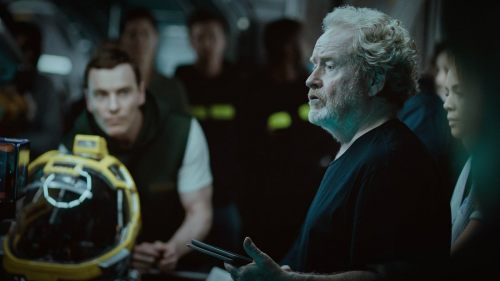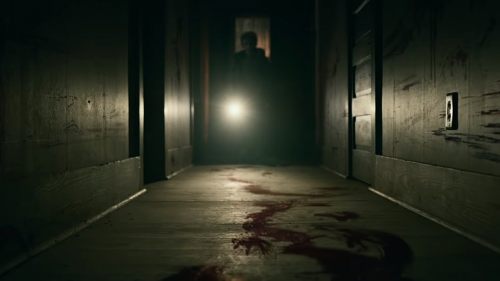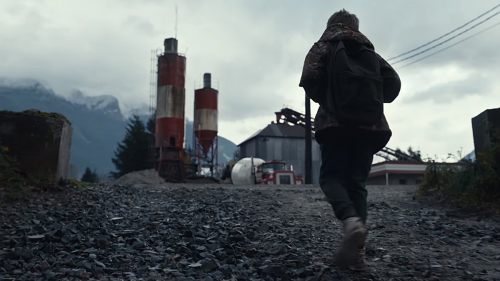Patron Saints Of Imperfection: On Guillermo Del Toro’s Love Of Monsters
The Shape of Water begins its theatrical run today. Get your tickets here!
“…when you go to a theater, it’s like you’re going to church. You sit in a pew, and you look at an altar…” — Guillermo del Toro, Cabinet of Curiosities
“Monsters are patron saints of imperfection.” — Guillermo del Toro
“If there’s trouble, all us freaks have is each other.” — Abe Sapien, Hellboy
As a five-year-old, Guillermo del Toro asked for a mandrake root for Christmas so he could perform black magic. His first monster was a toy werewolf he made with the help of a great-aunt when he was six. At seven, he bought his first book: Best Horror Stories edited by Forrest J. Ackerman. A picture still exists of young del Toro playing vampires with his sister, her neck covered in fake blood. When adults saw his drawings and paintings, they advised his mother to take him to a psychologist. The psychologist asked him to do whatever he wanted with clay, and young del Toro made a skeleton. A teacher assigned a class project, to choose a moment in the life of a president and make it in clay. It was another nightmare: del Toro rendered Kennedy’s assassination.
Guillermo del Toro’s love for monsters and the macabre is deep-seated. He was raised a strict Catholic, but God and angels and heaven did not help him make sense of his darker impulses and emotions as Catholicism only defines these feelings as sinful, even evil. Monsters became more realistic saints to him, and within his stories he reconfigures religious iconography like a symbolist painter to serve his perspective: crucifixions, stigmata, characters both Christ-like and Satanic, the end of the world, rosaries, resurrection. Catholics aspire to live in a state of grace, to be perfect; to worship monsters is to embrace the imperfect. In his films, Guillermo del Toro has created a pantheon of monsters out of his love for horror, a religion that blends Catholic ideas and imagery with fairytales.
Del Toro has called Mary Shelley’s Frankenstein an “emotional autobiography,” and Frankenstein’s creature is one of his films’ archetypes. Not unlike Satan, these characters are often fallen princes: Luke Goss’s Prince Nuada in Hellboy II: The Golden Army, Eduardo Noriega’s Jacinto in The Devil’s Backbone (“a prince without a kingdom,” as Carmen calls him. The reaper Nomak in Blade II is Frankenstein’s creature, the son of ancient vampire lord Damaskinos (Thomas Kretschmann). Nomak was engineered to be a “super vampire” and given a virus to make him a true immortal, immune to the effects of garlic, silver, sunlight. But the experiment fails. It is the vampire equivalent of Paradise Lost: Damaskinos considers Nomak a mistake and uses Blade (Wesley Snipes, obviously) and the Dirty Dozen of vampires to try killing him. Nomak emerges a sympathetic character, maybe even the story’s hero.
Hellboy II: The Golden Army aligns Hellboy with Frankenstein’s creature, a misunderstood hero regarded as a “freak” even by the people he protects. Liz’s recognition of Hellboy as a man and her love for Hellboy quite literally saves his life. And Mimic is the redemptive version of Frankenstein: entomologist Dr. Susan Tyler (Mira Sorvino) plays god, creating a new kind of creature to save humanity without considering the consequences. It’s not until she’s willing to risk her own life to save a little boy from these giant insects that humankind is redeemed.
In the director’s cut of Mimic, the film opens with the gruesome death of a priest backgrounded by a giant neon cross that reads, “Jesus Saves.” But it’s Susan who becomes a Christ figure: to distract a blood-loving man-size insect in order to save the life of a little boy, she gives herself stigmata with a rosary. Monsters are often saviors in del Toro’s universe as well. In Blade II, Blade saves the human race from vampires trying to create an ascendant race: the Reapers. Blade is crucified, spikes driven through his legs and hands. He then indulges his darkest impulse — his thirst — and drinking blood gives him the strength to be reborn, to fight more vampires, and to save the world. Hellboy opens on an image of Christ on the cross at the scene of Hellboy’s birth. Hellboy carries his adoptive father Professor Broom’s rosary, and at the film’s climax, his handler Agent Myers uses the rosary to remind him who he is: even though he’s destined to usher in the apocalypse, Hellboy can resist his fate, and he chooses to do the right thing by not ending the world.
In Guillermo del Toro’s universe, the real monsters are almost exclusively human: the fascists of Pan’s Labyrinth, Thomas’s and Lucille’s abusive parents in Crimson Peak, Hellboy’s Nazis, Blade II’s Nazi-esque vampires. They are villains obsessed with perfection, order. Cruelty and control and materialism define them. But even the most villainous monsters in del Toro’s films can be sympathetic. We may not love them, but we understand them — even Pan Labyrinth’s sadistic, legacy-obsessed captain Vidal or The Devil’s Backbone’s greed-driven Jacinto, once “the loneliest boy in the orphanage.” Crimson Peak’s Lucille (Jessica Chastain) is like Jane Eyre’s Bertha Rochester, given her own narrative beyond “the madwoman in the attic.” In voiceover Lucille explains: “Love makes monsters of us all.” But even Lucille isn’t the real monster here — it’s Thomas’s and Lucille’s parents who kept them locked in the attic and beat them. In character backstories written for Lucille and Thomas Sharpe, del Toro describes their mother as an “object of abuse,” and their father as “a shadow, a noise, an omen.” Perhaps the only truly evil entity in del Toro’s body of work is the Pale Man in Pan’s Labyrinth, a child-consuming creature who represents the church and, according to del Toro, “all institutional evil feeding on the helpless.”
While pure evil is rare in del Toro’s work, complicated characters who are both human and monster abound: a grandfather who becomes a vampire yet cannot bring himself to feed on the living, a mortal little girl who’s also the princess of the underworld, a big red humanoid demon who isn’t sure whether he should save the world or end it, a vampire hunter who is half-vampire himself, manmade monsters that fight monsters, a woman made monstrous by abuse and by love. These characters represent the duality of humans. Del Toro said in Cabinet of Curiosities that he preferred Hellboy’s love story to The Beauty and the Beast. Hellboy doesn’t turn into a handsome prince at the end of the story — Liz recognizes Hellboy’s humanity, she accepts him as he is, and she accepts what’s monstrous about herself.
In his introduction to H.P. Lovecraft’s The Thing on the Doorstep and Other Weird Tales, del Toro wrote that, “within the [horror] genre lies one of the last refuges of spirituality in this, our materialistic world.” Monsters teach us empathy for others and for ourselves. In that way, they can be as powerful as religious icons, if not more so. They are imperfect saints for imperfect people. In del Toro’s universe, there’s no such thing as heavenly perfection or true evil. There are only the choices we make: to help others, to sacrifice, to be kind. As he explained in Cabinet of Curiosities: “…ultimately, like Hundertwasser says: A straight line is pure tyranny. In art, as in life, the love of imperfection is the perfect love.”



